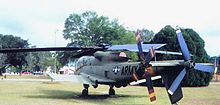United States Army Aviation Museum
| United States Army Aviation Museum | |
|---|---|
 Bitevní vrtulník Bell AH-1 Cobra vystavený před vchodem | |
| Údaje o muzeu | |
| Stát | |
| Město | Fort Rucker, Alabama |
| Vlastník | Army Aviation Museum Foundation |
| Založeno | 1956 (pro veřejnost otevřeno 1968) |
| Zaměření | letecké muzeum |
| Zeměpisné souřadnice | 31°19′27,12″ s. š., 85°42′47,16″ z. d. |
| Webové stránky | |
| Některá data mohou pocházet z datové položky. | |
United States Army Aviation Museum (česky ~ Muzeum letectví Armády Spojených států amerických) je letecké muzeum nacházející se ve Fort Rucker, nedaleko Daleville v Alabamě. Nachází se v něm celosvětově nejrozsáhlejší kolekce vrtulníků.[1][2] Muzeum veřejnosti zpřístupňuje okolo 50 letadel a množství artefaktů z historie letectví, sahajících od repliky vojenského dvouplošníku Model B bratří Wrightů po AH-64 Apache z operace Pouštní bouře. Ve sbírkách muzea se celkem nachází přes 160 letadel, a depozitáře obsahují celkem 3000 historických exponátů.[3]
Sbírka
Vystavené exponáty



- Wright Model B (replika)
- Hughes AH-64 Apache z operace Pouštní bouře
- Bell AH-1G a AH-1S Cobra
- Sikorsky H-19D Chickasaw
- Piasecki CH-21C Shawnee
- Sikorsky CH-37B Mojave
- Boeing-Vertol CH-47A Chinook
- Sikorsky CH-54A Tarhe
- H-23A Raven
- H-25A Army Mule
- OH-13C a OH-13E Sioux
- OH-23B Raven
- OH-58D Kiowa
- OH-6A Cayuse × 2
- R-4B Hoverfly I
- R-5 Dragonfly × 2
- Sikorsky R-6A Hoverfly II
- TH-13T Sioux
- TH-55A Osage
- HU-1B Iroquois (Huey) × 2
- UH-1H Iroquois
- YUH-1D/H Iroquois
- VH-34A (ex-Army One)
- AH-56A Cheyenne
- YAH-64A Apache
- YUH-60 Black Hawk
- Nieuport 28C-1
- Royal Aircraft Factory BE-2C
- Sopwith F.1 Camel (replika)
- Piper J-3 Cub
- Curtiss JN-4D Jenny
- Aeronca L-16A Champ
- Cessna L-19A Bird dog
- Taylorcraft L-2A Grasshopper
- Piper L-4B Cub
- Grumman OV-1B Mohawk
- Curtiss SE-5A
- de Havilland Canada U-1A Otter
- de Havilland Canada YC-7A Caribou
- de Havilland Canada YU-6A Beaver
Další významné exempláře
- Sikorsky S-72 Rotor Systems Research Aircraft (RSRA)
- McDonnell XV-1 Convertiplane
- Ryan XV-5B Vertifan
- Hawker XV-6A Kestrel
- Ryan VZ-3RY Vertiplane
- YH-41A Seneca
- Curtiss-Wright VZ-7
Zdroje: stránky US Army Aviation Museum[4][5][6]
Odkazy
Reference
V tomto článku byl použit překlad textu z článku United States Army Aviation Museum na anglické Wikipedii.
- ↑ Phillips 1992, s. 37
- ↑ Purner 2004, s. 204
- ↑ (anglicky) Army Aviation Museum Collection Archivováno 11. 12. 2016 na Wayback Machine.
- ↑ Museum Collection, rotary wing Archivováno 11. 12. 2016 na Wayback Machine., ArmyAviationMuseum.org.
- ↑ Museum Collection, fixed wing Archivováno 11. 12. 2016 na Wayback Machine., ArmyAviationMuseum.org.
- ↑ Museum Collection, vertical flight Archivováno 11. 12. 2016 na Wayback Machine., ArmyAviationMuseum.org.
Literatura
- PHILLIPS, Cody R. A Guide to U.S. Army Museums. [s.l.]: DIANE Publishing, 1992. ISBN 0-7881-4671-8. (anglicky)
- PURNER, John. 101 Best Aviation Attractions. [s.l.]: McGraw-Hill, 2004. Dostupné online. ISBN 0-07-142519-5. (anglicky)
Externí odkazy
 Obrázky, zvuky či videa k tématu United States Army Aviation Museum na Wikimedia Commons
Obrázky, zvuky či videa k tématu United States Army Aviation Museum na Wikimedia Commons - (anglicky) Oficiální stránky
- (anglicky) Fotogalerie na stránkách IPMSSantaRosa.org
Média použitá na této stránce
Autor: James Emery from Douglasville, United States, Licence: CC BY 2.0
"In response to the stated requirements for a Utility Tactical Transport Aircraft System (UTTAS), the Sikorsky company and Boeing-Vertol entered a competition to produce a prototype to be selected for production. Sikorsky's Model S-70 became the YUH-60A, and Boeing-Vertol's Model 179 was designated the YUH-61A. In 1976 when the modifications, tests, and competition finished, the Army selected the Sikorsky aircraft. By 1978 the first UH-60A "Blackhawks" were delivered. "This example, one of the original YUH-60A prototypes, featured a fully articulated 4-blade main rotor, a fixed position undercarriage landing gear, and a cabin large enough for a 3-4 man crew and an 11-man infantry squad. Significant modifications as a result of early tests included raising the heights of the main rotor above the fuselage by some 15 inches and adopting an all-moving tail surface. "The Blackhawk is capable of being configured with a hover infrared suppressor sub-system, a mine delivery system, an electronic countermeasures kit, as well as being capable of loading up to 16 Hellfire missiles (with an additional 16 in the cabin for reloading). The Army Special Operations forces also have unique requirements that include additional external fuel storage, uprated engines, provisions for air-to-air refueling, a rescue hoist, and advanced avionics. "The UH-60 series has seen modifications that have allowed its usage by all branches of the armed forces. The UH-60 series has proven to be one of the most powerful and versatile aircraft in the Army inventory to date."
from placard at the Army Aviation MuseumAutor: James Emery from Douglasville, United States, Licence: CC BY 2.0
U.S. Army Aviation Museum (front Cobra)_3845
AH-56A Cheyenne at U.S. Army Aviation Museum, Ft. Rucker, AL, displaying the stub-wing, and both tail rotors.
Autor: James Emery, Licence: CC BY 2.0
Sikorsky R-4B (43-46592) at U.S. Army Aviation Museum, Fort Rucker, (AL) (USA)




